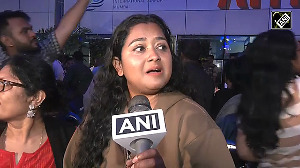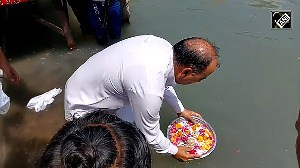All of a sudden, sting operations are 'hot' business for television news channels. India TV's recent spycam operation on actors Shakti Kapoor and Aman Verma ensured that the channel and its promoter Rajat Sharma get talked about.
A feat India TV could not achieve in nine months of its operation. Till the time of going to press TAM had not released last week's channel share figures -- but media experts say India TV's marketshare is expected to touch 10 per cent, compared to 5 per cent three weeks back.
So do news channels conduct sting operations with an eye on television rating points, hence, profits?
Channel executives would have you believe that sting operations are more of a crusade against crime.
"Zee wants to work in public interest. We believe in doing sting operations for the benefit of the masses," says Alka Saxena of Zee News.
Profit is not an issue as the 'expose' cannot be promoted or advertised since it has to be kept secret, she claims. "The channel, in fact, loses money in paying bribes. At times our gadgets are taken away by the investigating agency," she adds.
Agrees BAG Films' Ajit Anjum " The motive behind these sting operations is not profits but the excitement to expose corruption."
He, however, agrees that such programmes tend to boost the TRPs as the moment "recorded by a hidden camera" flashes on the screen, the viewer gets attentive.
BAG Films makes Red Alert for Star News for which it did a sting operation.
Invariably, higher TRP ratings translate into profits that accrue from advertisments. Devender Rawat, director of Sunrise Advertising Pvt Ltd, the agency that deals in local brands, says that India TV charged only Rs 500 per 10 seconds till about a week back.
"It has now hiked its rates to Rs 800 and may increase it further."
Besides profits from advertisements, sting operations spell neat dough for the channel through the SMS. For, almost all such programmes invoke viewers to send in their opinion through the SMS which is usually costlier by a rupee or two.
The channel shares this money with the service provider. "If India TV claims to have got over 100,000 SMSs following the telecast of Shakti Kapoor episode, then it certainly means it earned at least that much money, if not more, from the SMSs as well," points out a media industry source.
To be sure, more often than not, sting operations are costly affairs. The equipment may be cheap but the time spent on the operation, the man hours involved, the bribes paid (if the case requires), works out to be a tidy sum.
Hemant Sharma, executive editor, India TV, says "There's no way we can estimate the expenditure involved as an operation may take one day or four months."
According to Saxena, the cost depends on the type of operation and the level and number of people involved. Channels usually don't have a fixed budget for a sting operation as the exercise is often unpredictable.
BAG Films' sting operation on high profile models doubling up as prostitutes telecast in Red Alert on Star News reportedly cost more than Rs 20 lakh (Rs 2 million).
"We paid Rs 25,000 a day for a suite in Hotel Marriot, Mumbai, which we retained for several days. Besides each of the models was paid between Rs 2.5-3 lakh (Rs 250,000-300,000)," admits Anjum.
Sharma refused to divulge India TV's investment in the sting operations. But the cost of Aaj Tak's 'Ghoos Mahal' that exposed some 82 employees of the sales tax office in Delhi, ran into several lakh. Each employee was paid Rs 2,000 to 7,000 depending on his post.
Sometimes, after days of chasing a target the operation may be called off if the reporter is unable to establish the story. "In such a case the money goes down the drain," says Anjum.
So while channels claim to be dedicated to their mission of exposing the ugly face of corruption viewers seem to be gorging on visuals and sound bytes.
But media houses across the country are engaged in a debate on how far should one go to establish a story. "Television news in India is only a decade old. BBC has a detailed guideline spelling out everything -- from confidentiality to surreptitious recording. Channels need to be more responsible and concentrate on areas which have a prima facie evidence of crime," says Debang of NDTV.
The sting things
Hidden cameras in bags which were used in the 'defence deal' sting operation by the Tehelka team years ago are passe.
They have been replaced by tiny, often as minuscule as an inch, cameras that can be fitted in cigarette cases, watches, files and even buttons.
"While the reporter carries the camera, the transmitter or the receiver can either be in her pocket or with a person accompanying her or else in the car waiting outside," says Ajit Anjum of BAG Films.
Size is not the only USP of these sting operation gadgets. The picture quality and clarity offered by the lenses is amazing, pushing channels to rely on them. Incidentally, these spycams are not very expensive, especially when compared to the normal digicams used for recording news.
While a Sony PD 150 or PD 170, commonly used by news channels, costs anywhere between Rs 3.25 to Rs 3.5 lakh (Rs 325,000-350,000), the high-tech spycams cost anywhere between Rs 50,000 to Rs 1.5 lakh (Rs 150,000).
The quality of the recorder and the range of the transmitter ususally determines the price. And the good ones can have a lens as tiny as a pen point.
Needless to mention that these unique gadgets are of foreign make -- mostly Korean, Japanese and Taiwanese -- and available with only a few dealers in Delhi.
"Once the buyer pays at least a 75 per cent advance, we import it from the UK which takes approximately 7 to 8 days," informs Surendra Narang a dealer based in north Delhi.
Some cheaper, assembled equipment can also be found in the grey market flourishing in Karol Bagh's Gaffar market and Chandni Chowk. But what the television channels use, are mostly acquired from dealers whose identities are a closely guarded secret.
So while the electronic media journalists and their channels hog all the limelight for their respective sting missions, the real hero in the business is technology.
Hope the TV cameramen who once felt handicapped by the sheer size of their equipment have reasons to smile.








 © 2025
© 2025